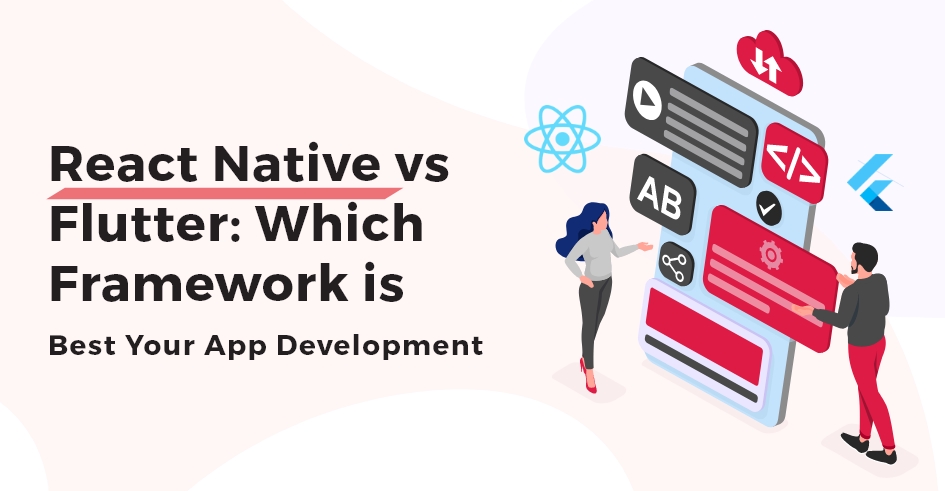React Native vs Flutter debate is still the talk of the tech town. When it comes to cross-platform app development, mobile app development companies face the dilemma of selecting the right framework that balances performance, scalability, and cost. With both React Native vs Flutter, how do you know which one is right for your project?
You might already be asking: Flutter vs React Native 2024 — which one will outperform? Which has the best developer tools or the strongest community support? Worse still, picking the wrong framework could mean wasted time and resources. No one wants an app that underdelivers or doesn’t perform well!
In the React Native vs Flutter debate for 2024, Flutter emerges as the best choice for visually complex, high-performance apps requiring intricate animations and cross-platform scalability (including web and desktop). Its native rendering engine and comprehensive widget-based system give it a performance edge, especially for graphics-heavy applications.
Let’s break down the key features of React Native vs Flutter in this comprehensive guide. We’ll dive deep into performance, popularity, and prospects and provide actionable insights to help you make the best decision. You can thank us later!
What is React Native?
React Native, backed by Facebook, is a widely-used framework that allows developers to build mobile apps using JavaScript. It’s not just about familiarity — it’s about the React library to develop native-like apps without reinventing the wheel. Imagine trying to find a quick fix for a UI glitch at 2 a.m. With React Native, chances are, someone has already posted a solution on StackOverflow! Here’s why it’s popular:
- JavaScript Ecosystem: JavaScript has been around for years and is well-supported. With a wealth of libraries, components, and tools, you’re never starting from scratch.
- Component-Based Architecture: Developers love the modularity React Native offers, where UI elements are designed as reusable components.
- Hot Reloading: This nifty feature allows you to immediately see the effects of changes you make in your code. Faster debugging = happier developers.
- Large Community Support: With an extensive community, there’s no shortage of tutorials, forums, and third-party libraries.
In React Native vs Flutter battle, lets look at Flutter in the next section.
What is Flutter?
If Flutter were a celebrity, it would be that cool newcomer who’s making waves in the industry. Developed by Google, Flutter’s biggest flex is its Dart programming language and its robust widget-based architecture.
- Dart Language: While it’s not as ubiquitous as JavaScript, Dart is a modern and scalable language designed to deliver high performance.
- Widgets Everywhere: In Flutter, everything is a widget. This gives developers complete control over the look and feel of their apps. It’s like having LEGO pieces that perfectly fit together.
- Hot Reload: Similar to React Native, Flutter lets you see the effects of code changes instantly. It’s perfect for rapid iteration.
- Built-in Design Support: Need an app that feels native on both iOS and Android? Flutter has built-in support for Material Design (Android) and Cupertino Design (iOS).
React Native vs Flutter Performance
Ah, the question on every developer’s mind: flutter vs react native performance — who wins? Both frameworks perform well, but there are important differences.
React Native relies on a JavaScript bridge to communicate with native components, which can lead to slight delays. Flutter, however, bypasses this by using its own rendering engine. That’s like cutting out the middleman to speed things up!
Compilation Differences
Flutter uses Ahead-Of-Time (AOT) compilation, leading to faster app start-up times and improved overall performance. React Native uses Just-In-Time (JIT) compilation, which might slow things down, especially during complex processes. In React Native vs Flutter, Flutter framework is created to display its user interface at a rate of 60 frames per second (fps), or at 120 fps on devices that can handle 120Hz updates. Each display of the user interface is referred to as a frame.
Think of React Native as driving through traffic with stoplights (JS bridge) versus Flutter, which uses a direct highway (native rendering engine). You’ll get to your destination faster with Flutter in certain situations!

Flutter Vs React Native Popularity : Who Takes The Crown?
In the flutter vs react native popularity debate, React Native still has a slight edge — mainly because it’s been around longer. It benefits from an enormous JavaScript community, many years of updates, and lots of tutorials. React Native feels like that popular high-school kid everyone knows.
However, Flutter is catching up. Google’s continuous updates and Flutter’s growing developer base are making it a serious contender. For instance, by 2024, we’re seeing increasing adoption, with many companies shifting to Flutter, thanks to its smoother performance and native look-and-feel.
Think of React Native as the original Avengers movie — loved by everyone — while Flutter is like the new generation of Marvel superheroes. The fans are growing fast!
How to Choose: React Native vs Flutter 2024
So, which should you go for? Both frameworks bring unique strengths, but certain factors can help you make a more informed decision:
1. Performance: Flutter vs React Native Performance in 2024
When comparing Flutter vs React Native performance, you’ll notice that Flutter tends to excel in apps that require high-performance graphics or animations. Flutter doesn’t rely on a JavaScript bridge like React Native, which can reduce overhead.
For example, an app with heavy animations or advanced UI elements (think of a gaming app) may perform better with Flutter due to its rendering engine. React Native, though, works perfectly fine for most apps and performs better for apps that don’t require complex UIs.
2. Popularity and Community: Flutter vs React Native Popularity
React Native has had a longer run, which means it enjoys a larger community and a broader range of third-party libraries. However, Flutter’s community is growing quickly, with companies like Google backing it and using it for their projects. Fun fact: Flutter is used in Google Ads!
If you’re looking for a framework with more tutorials, solutions, and libraries, React Native still holds the edge. But, if you want to hop onto a rapidly growing ship with a future-forward approach, Flutter’s your bet.
3. Performance Under Pressure: React Native vs Flutter Performance 2024
Both frameworks perform exceptionally well for most apps, but React Native’s reliance on the JavaScript bridge might cause performance issues in complex apps. Flutter, with its AOT compilation and direct compilation into native code, often has the upper hand in terms of speed.
Example: If you’re developing an app for financial analytics, which requires real-time data updates and chart animations, Flutter’s faster rendering and smoother performance might give you that edge.
When to Choose React Native vs Flutter in 2024
Go with React Native if Your team has expertise in JavaScript. You’re developing an app that doesn’t have complex UIs or require intensive animations. You want the flexibility of tapping into an extensive library of third-party packages and community support.
If you’re building an app like Snapchat, React Native’s efficiency in handling user profiles, messaging, media sharing, navigation, content loading, and animations across platforms ensures a smooth and consistent user experience. You can hire an iOS app development agency to build an app without sacrificing performance.
Choose Flutter if You want to create highly customizable UIs with intricate animations. You’re building apps that need superior performance in areas like graphics or gaming. Your project has a long-term scope, and you’re willing to invest in learning Dart, a relatively newer language.
Let’s say you’re building a travel booking app with interactive animations and a need for high performance. With Flutter’s direct rendering engine, you’ll be able to give your users an incredibly smooth, native experience on both iOS and Android.
React Native Vs Flutter 2024
Here’s some fresh information on React Native vs Flutter for 2024 that considers the latest trends and updates in both frameworks:
1. New Features & Updates
In flutter vs react native 2024, React Native has introduced Fabric, a new rendering engine aimed at improving performance and flexibility. Fabric enables more efficient interactions between the JavaScript and native layers by using asynchronous rendering. This means faster updates and a smoother user experience, particularly for apps with complex UI interactions.
React Native has rolled out TurboModules, a new architecture that allows faster interaction between JavaScript and native modules. This means quicker start times and reduced memory usage, which is perfect for apps that need to be light and fast.
In React Native 2024, Hermes, Facebook’s custom JavaScript engine, is now the default engine for React Native apps. Hermes reduces app start-up times and memory usage, especially beneficial for apps running on lower-end devices.
2. Flutter Updates
In flutter vs react native 2024, Flutter has implemented its Impeller engine, which replaces the older Skia rendering engine. Impeller improves rendering performance, particularly for apps with complex 2D and 3D animations. This upgrade makes Flutter even more suitable for building graphically rich applications, such as gaming or media-heavy apps.
One of the significant advantages Flutter offers in 2024 is its full multi-platform support. You can now write apps for iOS, Android, web, desktop (Windows, macOS, Linux) with a single codebase. This is a major factor for companies looking to unify their app development efforts across platforms, making Flutter an all-in-one solution.
Flutter now runs on Dart 3.0, which has improved features like null safety (preventing potential crashes) and performance optimizations. This makes the framework more secure and efficient in handling large-scale projects.
3. Performance & Battery Optimization
The introduction of Concurrent Rendering in React Native’s Fabric architecture improves performance for apps with real-time data processing or heavy user interactions. TurboModules help decrease overhead in communication between JavaScript and native modules, making it easier to optimize battery usage and system resources.
With the new Impeller Renderer and Ahead-of-Time (AOT) compilation, Flutter’s battery efficiency has improved. The latest updates make it an ideal choice for apps with high graphical demands, ensuring that animations and visuals remain smooth without draining too much battery life.
4. Community Growth and Ecosystem
While React Native already has a large community, in 2024, it benefits from even more third-party integrations and plugin libraries, making it easier to build complex apps quickly. The React Native ecosystem has matured significantly, and support for platform-specific APIs like AR/VR, native gestures, and voice recognition has expanded.
Flutter’s ecosystem has seen rapid growth, particularly in enterprise adoption. Companies like Alibaba, eBay, and BMW have heavily invested in Flutter for their cross-platform needs. Flutter’s package repository, pub.dev, now hosts thousands of open-source plugins and tools, bridging gaps for niche app functionalities.
5. Tooling and Developer Experience
Metro bundler, the default bundler for React Native, has been improved in 2024. It is now faster and more stable, reducing build times. The integration with React 18 enables concurrent features for rendering that can make the user experience even smoother.
The Flutter DevTools suite has received significant updates, including more powerful debugging and performance tracking features. In 2024, better support for desktop app debugging has made Flutter more developer-friendly for multi-platform apps. The Visual Studio Code extensions for Flutter have also been enhanced to support easier testing, profiling, and UI design.
6. Industry Adoption in 2024
Meta, Airbnb, and apps like Uber Eats continue to leverage React Native, especially for apps that require real-time updates and complex integrations with existing JavaScript-heavy ecosystems. React Native’s robust support for backend integrations and scaling capabilities make it a go-to for apps requiring quick iterations and updates.
In react native vs flutter 2024, Flutter has become a favorite for startups and enterprise-level apps alike, particularly those seeking rapid development across platforms. Companies in industries like FinTech and EdTech (e.g., Google Pay, Nubank) have increasingly turned to Flutter for its smooth user interfaces and rapid development cycles. Flutter’s ability to seamlessly transition from mobile to web and desktop has made it an ideal choice for companies with diverse digital needs.
Flutter vs React Native Future
The flutter vs react native future remains bright for both frameworks. React Native’s future continues to benefit from Facebook’s ongoing investment and the vast ecosystem it has built. Flutter’s future, on the other hand, is bolstered by Google’s backing and its potential to create beautiful, high-performance apps. Flutter is also making strides into different platforms, like web and desktop apps, which could potentially make it an even more appealing option in the future.
React Native’s longevity continues due to its vast ecosystem and Facebook’s dedication to its improvement. The new architecture, paired with the Hermes engine, solidifies its place for building apps that need quick iteration cycles and deep integration with web-based frameworks.
Flutter’s increasing push towards a “write once, run everywhere” approach has made it a formidable competitor, not only for mobile but also for web, desktop, and even embedded applications. Flutter’s future lies in its growing ability to support new platforms, with Flutter 4.0 likely to increase its focus on multi-platform optimizations.
The Final Verdict: React Native vs Flutter 2024
In the battle of React Native vs Flutter 2024, there isn’t a clear winner. The choice ultimately comes down to your app development-specific needs and your team’s expertise.
React Native may be the safer bet for most apps due to its larger community and JavaScript support, but Flutter offers an edge in performance-heavy apps or when you’re aiming for a more visually impressive design.
Want to make an informed decision? Try TechnBrains a simple proof-of-concept app in both frameworks. It’s a great way to feel the differences firsthand. Or, as the popular saying goes, “Try them both—who needs free time, right?”
In the end, whether you choose React Native or Flutter, you’ll be building an app that can run on both iOS and Android—saving time, money, and resources. That’s a win in anyone’s book!
TechnBrains can build Visually Appealing Apps For You
As a flutter app development company, we focus on creating vibrant interfaces that are easy to use. Whether you need an app for iOS, Android, or multiple platforms, our team makes sure everything is pixel-perfect. We go beyond React Native vs Flutter by focusing on the overall functionality too.
Not only do we design apps that look great, but we also ensure they work exceptionally well. You’ll get an app that loads quickly, navigates easily, and responds instantly to user commands. It’s not just about making an app look pretty – it’s about making it functional and user-friendly too.
You may wonder, why TechnBrains? Here’s a simple answer: We specialize in building beautiful apps that perform just as great. No more worrying about your app crashing or slow load times. Our design and development process ensures your app looks stunning and runs flawlessly.
Think of it this way: your app is an extension of your brand. You don’t want it to feel generic or copy-paste. With us, your app stands out and remains aligned with your brand’s personality. In short, we build apps that people love to use.
It’s time to stop worrying about building an app that only looks good. Partner with TechnBrains – a flutter app development company that brings both visual appeal and high performance to the table.






